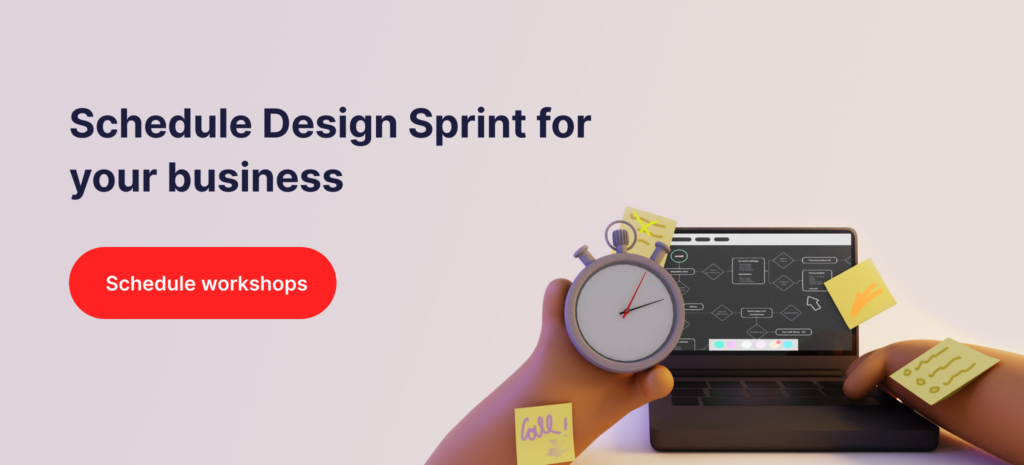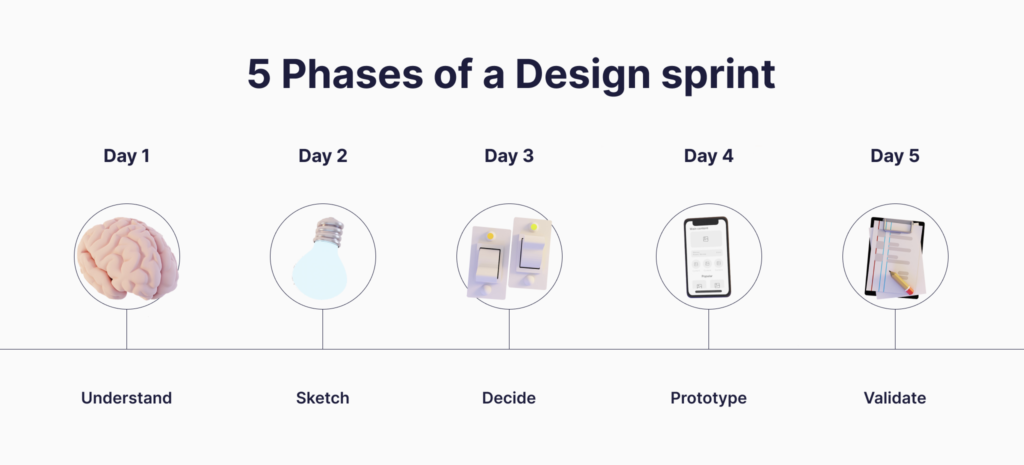Let’s start with the most obvious question – What is PropTech? The name PropTech is an amalgamation of the words “property” and “technology”, and is also commonly referred to […]
The design sprint is a five-day workshop focused on validating design hypotheses and answering critical business questions. Through rapid prototyping and testing processes, participants work out the direction of their product and business model. When performed right, it saves companies a lot of time spent on ineffective brainstorming and resources invested in untested features. However, if you want to get a valuable outcome first, you need to know how to run such workshops.
The product design framework (PDS) is applied for many different reasons. Teams use it to kick-off their projects, to speed up the development, or to leverage new data or research. The idea behind the framework is to use prototyping, user research, and testing to solve complex problems. The process is flexible enough to be adopted in a way that serves your own purpose. Now let’s move on to the value it brings.
Starting off with such an intense and focused workshop gives you a huge advantage. After it’s done, you no longer guess the aim or the necessary features of your product – you are perfectly sure what you need.
Investing money into untested ideas is the shortest way to a failure. Companies often risk their resources having nothing to support their motives. Design sprint represents the opposite approach. It reduces the risk by forcing companies to base their actions on reliable data.
The process shortcuts months of debating on features and development. By challenging product design and strategy with the use of real users, you can quickly validate your ideas and save both time and money.
Design sprint lets you set up a development path for your project by exploring possible directions. In just 5 days you get to work out the plan to follow for the next months.
The workshop requires the collaboration of a cross-functional team. It gathers members of different disciplines in one place to focus on one goal. The result is effective, boiling teamwork that leads to valuable conclusions.


Design sprint follows five phases:
Everyone should be on the same page. That is why the first stage is about sharing prior technical and user knowledge about the product and discussing business goals. After reviewing the background and all the user insights, the team creates a user journey and tries to map out the pain points. Then there’s a discussion on how might we solve the issues and improve the current process.
The next phase is about brainstorming and defining the desired outcomes and possible solutions. Everyone individually tries to come up with multiple sketches of the solution which are then presented to the group. Then, the team works together to narrow down the ideas to one sketch per person. If the workshops are held online, the group work can be transferred to a tool like Figma. A popular exercise is also Crazy 8’s where each person needs to sketch 8 different ideas in 8 minutes.
Now is the time for voting and choosing the final direction. Everyone gets approx. three minutes to present their solution while other people may ask questions or write down their thoughts. Very often people have different opinions about the presented work. That’s why it’s good to hang all the sketches on the wall and let one person sum up the core approach of each idea. Silent voting is also helpful in optimizing the time needed to choose the Sprint focus.
At this stage, the sprint team works together to create a prototype which is, in fact, a minimum viable concept that can be validated later. This type of prototype shouldn’t take much time, it has to include only enough details to attract potential users and gain feedback. The group chooses which steps in the user flow should be tested as a priority and starts the process of prototyping.
Finally, the user research! The concept is presented to real users who now can interact with the prototype and provide the group with feedback on the solution. This is the most valuable stage where the sprint hypothesis is either accepted or rejected by the target group. The users usually point out things worth the improvement which in turn leads to working out a better UX.


They say planning the workshop is even more important than performing it. Take that seriously and organize days so that each ends up with valuable insights and summaries.
The brief should include a list of defined goals, deliverables, agenda, and a description of the way people will work on the solution (group exercises and tools used). The document should also provide the sprint team with background for the project and any data that are already collected.
It’s good to have a team of five to eight people (depending on the aim and complexity of the project). An ideal project team includes:
Creating visuals means gathering all the inspiration sources, screenshots, data, and research summaries in one place so that the sprint team can always refer to them when working on a solution. Sharing data insight will also help the people create something useful and reliable based on the information provided.
It’s good to perform user research upfront to provide the group with information on how people are currently using the product. The data can be presented at the Understand phase to help kick off the process and provide team members with knowledge on things worth the improvement.
Warm up the crowd before starting the actual design sprint. It stimulates creative thinking and strengthens the relationship between team members right at the beginning of workshops.
When things happen online, there are multiple helpful tools to visualize the work for the whole team such as Miro.io or Figma. It’s also good to have a tool where the progress in the sprint can be monitored such as Hive or JIRA.
The design sprint is hard work. Such an intense effort deserves to be rewarded! End the process with a little celebration so that the participants can enjoy the moment before another week of developing the product.
If you wish to take part in a process designed specifically for the purpose of your growth – contact our team and let’s kick off your idea!